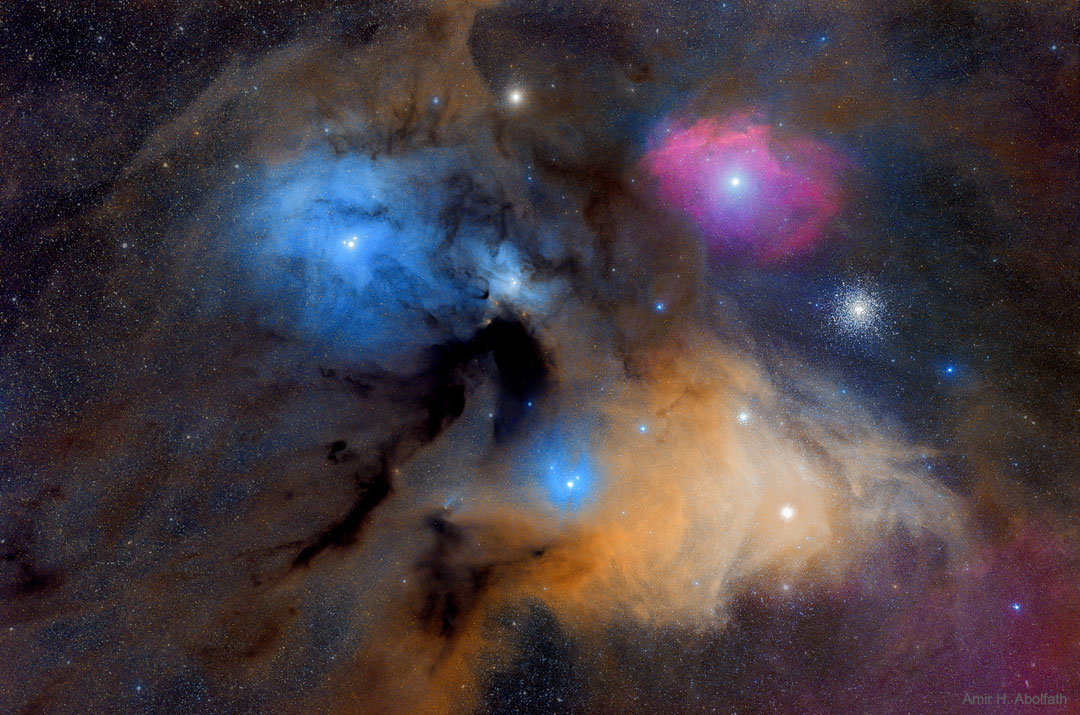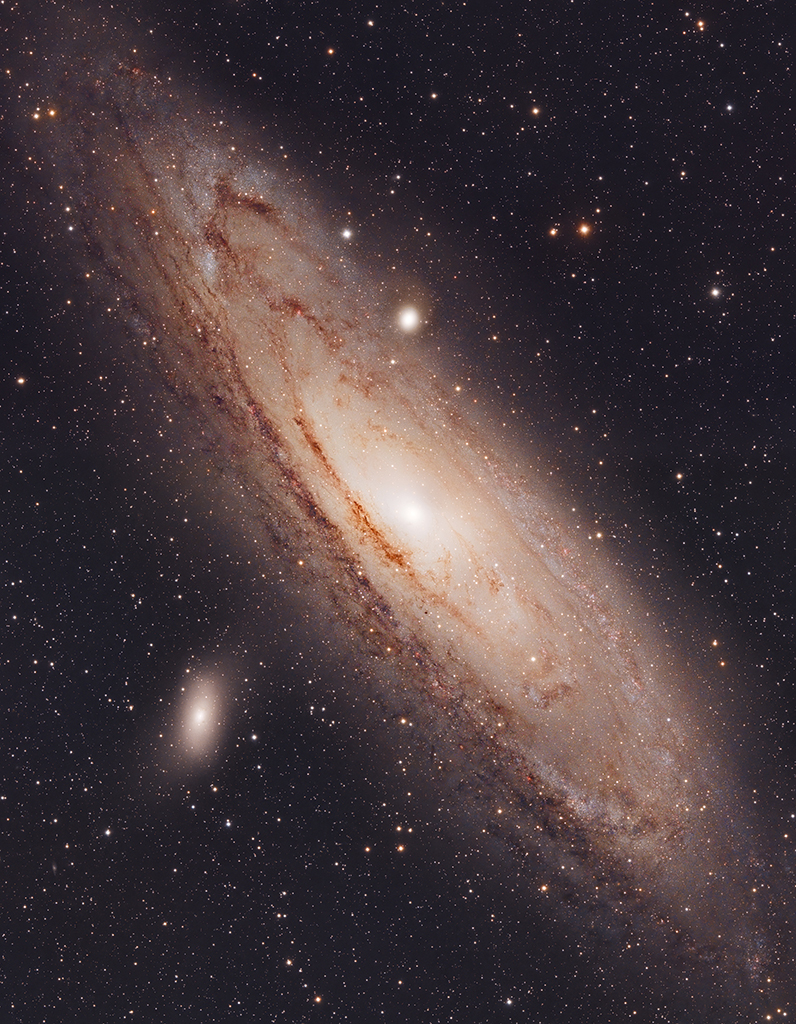Blog
The many spectacular colors of the Rho Ophiuchi (oh’-fee-yu-kee) clouds highlight the many processes that occur there. The blue regions shine primarily by reflected light. Blue light from the Rho Ophiuchi star system and nearby stars reflects more efficiently off this portion of the nebula than red light. The Earth’s daytime sky appears blue for the same reason. The red and yellow regions shine primarily because of emissionfrom the nebula’s atomic and molecular gas. Light from nearby blue stars – more energetic than the bright star Antares – knocks electrons away from the gas, which then shines when the electrons recombine with the gas. The dark brown regions are caused by dust grains – born in young stellar atmospheres – which effectively block light emitted behind them. The Rho Ophiuchi star clouds, well in front of the globular cluster M4 visible hereon the upper right, are even more colorful than humans can see – the clouds emits light in every wavelength band from the radio to the gamma-ray.

James “Son” Thomas (October 14, 1926 – June 26, 1993) was an American Delta blues musician, gravedigger and sculptor from Leland, Mississippi.
Thomas was born in Eden, Mississippi on October 14, 1926. While working in the fields, he began listening to blues on the radio. As a self-taught guitarist, he learned to play songs from older blues guitarists Elmore Davis and Arthur “Big Boy” Crudup. He then worked as a gravedigger in Washington County.
Thomas became known after appearing in films made by the Center for Southern Folklore in the 1970s. He appeared in the films Delta Blues Singer: James “Sonny Ford” Thomas, Give My Poor Heart Ease: Mississippi Delta Bluesmen, and Mississippi Delta Blues. In the 1970s, Eddie Cusic performed with Thomas at regular engagements. Together they recorded “Once I Had a Car”, which is included on the compilation album Mississippi Delta & South Tennessee Blues (1977). In the 1980s, Thomas recorded internationally.
more...Robert Parker (October 14, 1930 – January 19, 2020) was an American R&B singer and musician, best known for his 1966 hit, “Barefootin’“.
Robert Parker, Jr. was born in Mobile, Alabama to Robert and Leana Parker. He grew up in New Orleans, Louisiana, and started his career as a saxophonist, playing with Professor Longhair on his hit “Mardi Gras In New Orleans” in 1949. Over the next decade, he played with most of New Orleans’ musicians, including Fats Domino, Irma Thomas, and Huey “Piano” Smith.
more...Jewell Stovall, better known as Babe Stovall (October 14, 1907 – September 21, 1974), was an American Delta blues singer and guitarist.
Stovall was born in Tylertown, Mississippi, United States, in 1907, the youngest of eleven children (thus his nickname “Babe”). He learned to play the guitar by the age of eight, and his guitar playing style was influenced by Tommy Johnson, whom he had met in Mississippi around 1930. In 1964, he relocated to New Orleans, Louisiana, where he entertained on the streets, and in cafes and galleries of the French Quarter. Stovall frequently took young white musicians under his wing as apprentice performers, teaching them traditional country blues songs and guitar techniques. He variously played his guitar at the back of his neck, and hollered his song lyrics loudly for all in the vicinity to hear. In 1964 he recorded an album for Verve, titled Babe Stovall (which was re-released in 1990 on CD), and undertook more recordings in 1966, released as The Babe Stovall Story. His later work with Bob West resulted in The Old Ace: Mississippi Blues & Religious Songs, which was released on Arcola (2003). He was credited by some as the character inspiration behind Jerry Jeff Walker‘s, “Mr. Bojangles”.
Stovall played on the college circuit, in addition to being the regular musician at the Dream Castel Bar on Frenchman Street, and The Quarum club in New Orleans.
more...https://www.youtube.com/watch?v=ll832gQ4w6s&list=PLt8BlFp9aVd1nYN8ZtswCYjTInVosHQkw
more...https://www.youtube.com/watch?v=1ynJ-26TELg
more...The Andromeda Galaxy, also known as Messier 31, is one of the most observed and photographed objects in the night sky. It’s a spiral galaxy like our Milky Way at a distance of 2.5 million light-years.

Paul Frederic Simon (born October 13, 1941) is an American musician, singer, songwriter and actor. Simon’s musical career has spanned over six decades. He reached fame and commercial success as half of the duo Simon & Garfunkel, formed in 1956 with Art Garfunkel. Simon wrote nearly all of their songs, including US number-one singles “The Sound of Silence“, “Mrs. Robinson“, and “Bridge over Troubled Water“.
After Simon & Garfunkel split up in 1970, at the height of their popularity, Simon began a successful solo career. He recorded three acclaimed albums over the following five years. In 1986, following a career slump, he released Graceland, an album inspired by South African township music, which sold 14 million copies worldwide and remains his most popular solo work. Simon also wrote and starred in the film One-Trick Pony (1980) and co-wrote the Broadway musical The Capeman (1998) with the poet Derek Walcott. On June 3, 2016, Simon released his 13th solo album, Stranger to Stranger, which debuted at number one on the Billboard Album Chart and the UK Albums Chart.
Simon has earned sixteen Grammy awards for his solo and collaborative work, including three for Album of the Year (Bridge Over Troubled Water, Still Crazy After All These Years, and Graceland), and a Lifetime Achievement Award. He is a two-time inductee into the Rock and Roll Hall of Fame: first in 1990 as a member of Simon & Garfunkel and again in 2001 for his solo career. In 2006 he was selected as one of the “100 People Who Shaped the World” by Time. In 2011, Rolling Stone named Simon one of the 100 greatest guitarists, and in 2015 he was ranked eighth in their list of the 100 Greatest Songwriters of All Time.[9] Simon was the first recipient of the Library of Congress‘s Gershwin Prize for Popular Song in 2007.
Simon was born on October 13, 1941, in Newark, New Jersey, to Hungarian-Jewish parents. His father, Louis (1916–1995), was a college professor, double-bass player, and dance bandleader who performed under the name “Lee Sims”. His mother, Belle (1910–2007), was an elementary school teacher. In 1945, his family moved to the Kew Gardens Hills section of Flushing, Queens, in New York City.
more...Pharoah Sanders (born Farrell Sanders, October 13, 1940) is an American jazz saxophonist. A member of John Coltrane‘s groups of the mid-1960s, Sanders is known for his overblowing, harmonic, and multiphonic techniques on the saxophone, as well as his use of “sheets of sound“. He has released over 30 albums as a leader and has collaborated extensively with Leon Thomas, Alice Coltrane and Tisziji Muñoz, among others. Saxophonist Ornette Coleman described him as “probably the best tenor player in the world”.
Sanders’ music has been called “spiritual jazz” due to his inspiration in religious concepts such as Karma and Tawhid, and his rich, meditative aesthetic. This style is seen as a continuation of Coltrane’s work on albums such as A Love Supreme. As a result, Sanders is considered a disciple of Coltrane or, as Albert Ayler said, “Trane was the Father, Pharoah was the Son, I am the Holy Ghost”.
Pharoah Sanders was born on October 13, 1940, in Little Rock, Arkansas. His mother worked as a cook in a school cafeteria, and his father worked for the City of Little Rock. An only child, Sanders began his musical career accompanying church hymns on clarinet. His initial artistic accomplishments were in the visual arts, but when he was at Scipio Jones High School in North Little Rock, Sanders began playing the tenor saxophone. The band director, Jimmy Cannon, was also a saxophone player and introduced Sanders to jazz. When Cannon left, Sanders, although still a student, took over as the band director until a permanent director could be found.
During the late 1950s, Sanders would often sneak into African-American clubs in downtown Little Rock to play with acts that were passing through. At the time, Little Rock was part of the touring route through Memphis, Tennessee, and Hot Springs for R&B and jazz musicians. Sanders found himself limited by the state’s segregation and the R&B and jazz standards that dominated the Little Rock music scene.
After finishing high school in 1959, Sanders moved to Oakland, California, and lived with relatives. He briefly attended Oakland Junior College and studied art and music. Once outside the Jim Crow South, Sanders could play in both black and white clubs. His Arkansas connection stuck with him in the Bay Area with the nickname of “Little Rock.” It was also during this time that he met and befriended John Coltrane.
more...Leon Konitz (October 13, 1927 – April 15, 2020) was an American composer and alto saxophonist.
He performed successfully in a wide range of jazz styles, including bebop, cool jazz, and avant-garde jazz. Konitz’s association with the cool jazz movement of the 1940s and 1950s includes participation in Miles Davis‘s Birth of the Cool sessions and his work with pianist Lennie Tristano. He was one of relatively few alto saxophonists of this era to retain a distinctive style, when Charlie Parker exerted a massive influence. Like other students of Tristano, Konitz improvised long, melodic lines with the rhythmic interest coming from odd accents, or odd note groupings suggestive of the imposition of one time signature over another. Other saxophonists were strongly influenced by Konitz, such as Paul Desmond and Art Pepper.
He died during the COVID-19 pandemic due to complications brought on by the disease.
Leon Konitz was born on October 13, 1927, in Chicago to Jewish parents of Austrian and Russian descent. At the age of eleven, Konitz received his first clarinet. However, he later dropped the instrument in favor of the tenor saxophone. He eventually moved from tenor to alto. His greatest influences at the time were the swing big bands he and his brother listened to on the radio; hearing Benny Goodman on the radio was what prodded him to ask for a clarinet. He improvised on the saxophone before learning to play standards.
more...Raymond Matthews Brown (October 13, 1926 – July 2, 2002) was an American jazz double bassist known for extensive work with Oscar Petersonand Ella Fitzgerald.
Ray Brown was born October 13, 1926 in Pittsburgh, Pennsylvania and took piano lessons from the age of eight. After noticing how many pianists attended his high school, he thought of taking up the trombone but was unable to afford one. With a vacancy in the high school jazz orchestra, he took up the upright bass.
A major early influence on Brown’s bass playing was Jimmy Blanton, the bassist in the Duke Ellington band. As a young man Brown became increasingly well known in the Pittsburgh jazz scene, with his first experiences playing in bands with the Jimmy Hinsley Sextet and the Snookum Russell band. After graduating high school, having heard stories about the burgeoning jazz scene on 52nd Street in New York City, he bought a one-way ticket to New York. He arrived in New York at the age of 20, met up with Hank Jones, with whom he had previously worked, and was introduced to Dizzy Gillespie, who was looking for a bass player. Gillespie hired Brown on the spot, and he soon played with such established musicians as Art Tatum and Charlie Parker. In 1948, Brown left Dizzy’s band to start a trio with Hank Jones and Charlie Smith.
more...Arthur Tatum Jr. (/ˈteɪtəm/, October 13, 1909 – November 5, 1956 Toledo,OH) was an American jazz pianist who is widely regarded as one of the greatest in his field.
Tatum grew up in Toledo, Ohio, where he began playing piano professionally and had his own radio program, rebroadcast nationwide, while still in his teens. He left Toledo in 1932 and had residencies as a solo pianist at clubs in major urban centers including New York, Chicago, and Los Angeles. Throughout his career, Tatum also played in after-hours venues at which he was said to be more spontaneous and creative than in his regular paid performances. Tatum drank large quantities of alcohol when performing; although it did not negatively affect his playing, it damaged his health. In the 1940s, Tatum led a commercially successful trio for a short time and began playing in more formal jazz concert settings, including at Norman Granz-produced Jazz at the Philharmonic events. Granz recorded Tatum extensively in solo and small group formats in the mid-1950s, with the last session occurring only two months before the pianist’s death from uremia at the age of 47.
His playing encompassed the styles of earlier muysicians, while adding harmonic and rhythmic imagination and complexity. Acclaimed for his virtuoso technique, Tatum extended the vocabulary and boundaries of jazz piano, and established new ground in jazz through innovative use of reharmonization, voicing, and bitonality.
https://www.youtube.com/watch?v=HlRvazf3_7k
more...Club Calabash has moved to YouTube. This is mick’s Stones Rub a Dub mix of a Bobby Womack tune.
more...More Posts
- World Music with Nadya Giga and Their 101 Candles Orchestra
- Daily Roots with Cornell Campbell
- The Cosmos with the Antares
- Charlie Watts Day
- Ahmed Jamal Day
- World Music with Mamady Keita
- Daily Roots with Leroy Smart
- The Cosmos with IC 5332
- Leon “Ndugu” Chancler Day
- James Cotton Day
- Willie Dixon Day
- World Music with Music Maya Aj
- Daily Roots with Horace Andy
- The Cosmos with Trapezium Cluster
- Stanley Clarke Day
- Andrew Hill Day
- World Music with Nico Kasanda
- Daily Roots with Hortense Ellis
- The Cosmos with M24
- Gilberto Gil Day
